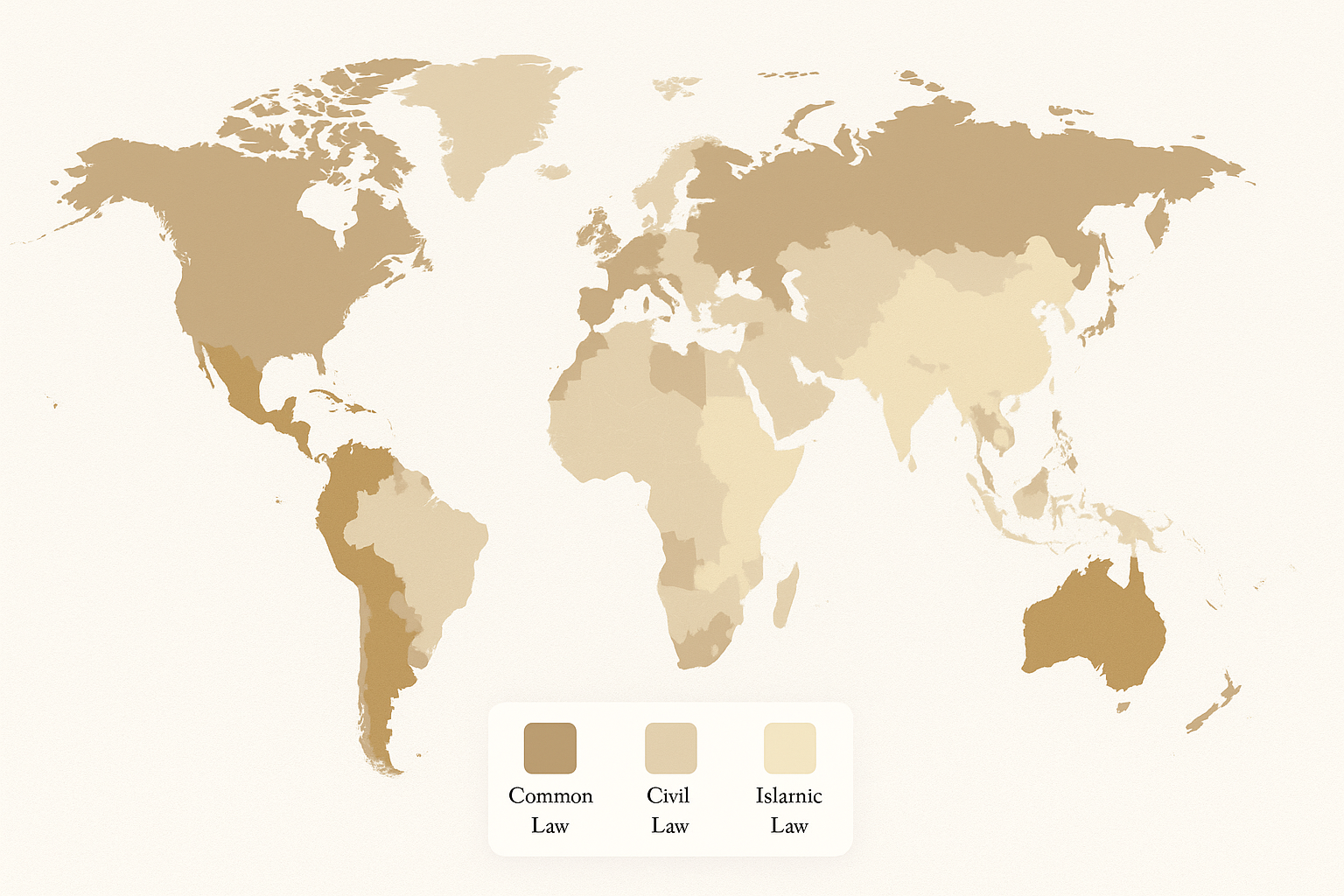Fundamentals: Legal Families and Applicable Law
National legal systems around the world can generally be grouped into three major legal families:
Civil Law (Continental Law): Civil law systems are based on codified statutes and regulations. They are predominant in continental Europe and many other parts of the world. These systems have a well-developed body of private law, including comprehensive rules governing contracts and commercial transactions (contract law).
Common Law (Anglo-American Law): Unlike civil law, common law is largely uncodified and is primarily shaped by judicial decisions and legal precedents (known as "case law"). Common law systems are prevalent in the UK, the United States, and many other English-speaking countries. They feature fully developed private law systems, with contract and commercial law playing a particularly central role. Notably, common law contract principles have gained international influence, even in jurisdictions that do not follow this legal tradition.
Islamic Religious Law*: In many Islamic countries, religious law influences the legal system to varying degrees. While criminal and family law are often deeply rooted in Islamic traditions, contract law is generally less developed and may be supplemented by other legal sources.
*Note: For the purpose of this website, contracts governed by Islamic religious law are not further considered.
Illustration: Global Distribution of Major Legal Families
Civil Law vs. Common Law Contracts
Because of their different legal traditions, contract drafting and interpretation differ significantly between civil and common law systems.
In civil law jurisdictions, contracts tend to be more concise, as statutory provisions often act as a safety net that fills in gaps and resolves ambiguities.
In common law jurisdictions, contracts are typically longer and more detailed, since fewer statutory fallback rules exist. The enforceability of a contract depends heavily on the specific language used, which must account for a wide range of possible scenarios and risks
This distinction affects not only how contracts are written but also how they are negotiated, interpreted, and enforced.
Why Common Law Matters in International Contracts
In international business, English law and New York law are frequently chosen as the governing law — even when the parties are not based in common law jurisdictions. This preference is driven by several factors:
Predictability and precedent: Common law’s reliance on judicial decisions creates a well-documented body of case law that supports legal certainty.
Familiarity in global markets: Commercial lawyers and multinational companies often feel more comfortable operating under systems they perceive as business-friendly and internationally recognized.
Neutrality: Selecting a common law system can serve as a compromise when neither party wants the other’s national law to apply.
As a result, understanding the structure and logic of common law contracts is highly valuable for international contract professionals — regardless of their own legal background. The next section of the Content Hub provides insights into the specific characteristics of contract language in Anglo-American contracts.
Applicable Law
Just as a fish needs water in order to live, a contract needs its legal “environment” — the applicable law. The applicable law determines the framework within which the rights and obligations of the parties take effect and is therefore essential to the interpretation and enforceability of the contract.
In most legal systems, the parties are free to choose which private law will govern their contract. This “choice of law” is typically set out in a dedicated clause — often located toward the end of the contract.
Print Sources:
Pinnells, James / Eversberg, Arndt: Internationale Kaufverträge optimal gestalten. Leitfaden mit zahlreichen Musterklauseln. 3rd ed., C.H. Beck, Munich, 2021.
Cordero-Moss, Giuditta: International Commercial Contracts: Applicable Sources and Enforceability. Cambridge University Press, Cambridge, 2014.
Smits, Jan M.: Contract Law: A Comparative Introduction. Edward Elgar Publishing, Cheltenham/Northampton, 2014.
Bortolotti, Fabio: Drafting and Negotiating International Commercial Contracts. 3rd ed., ICC Publishing, Paris, 2017.
UNIDROIT: UNIDROIT Principles of International Commercial Contracts (PICC). 2016 ed., International Institute for the Unification of Private Law (UNIDROIT), Rome.
Zimmermann, Reinhard: Comparative Law and the Europeanization of Private Law. Oxford University Press, Oxford, 2006.
Glenn, H. Patrick: Legal Traditions of the World: Sustainable Diversity in Law. 5th ed., Oxford University Press, Oxford, 2014.
Online Sources:
World Bank: Doing Business Reports. Various editions, Washington, D.C., 2004–2020. Available at: https://www.doingbusiness.org (archived site)
University of Ottawa – JuriGlobe Research Group: World Legal Systems Map. Available at: http://www.juriglobe.ca
OECD / United Nations: Reports on National Legal Frameworks. Various publications, 2000–2023. Available at: https://www.oecd.org and https://www.un.org
